HJC RPHA Max Helmet Review
The HJC RPHA Max is a new flip-up helmet with a strange name and convoluted product release.
Fortunately, the helmet is a winner.
It has solid construction, tight tolerances and excellent ventilation, along with excellent noise control.
Is it worth $160.00 more than the competition…which happens to be a close relative, the HJC SyMax III (review)?
The HJC RPHA Max was introduced at the 2012 Dealer Expo in Indianapolis, Indiana in this webBikeWorld report.
The product announcement was confusing and, to a certain extent, it still is.
What is now known as the RPHA product line was originally known as “R-PHA” with a stylized “RP” logo, according to the press information from the 2012 Dealer Expo.
It wasn’t clear at the time whether this would be an HJC-branded helmet or an entirely new product line.
And HJC also had an “RPS” product line at the time, with the HJC RPS-10 (review) as the sole entry.
The company has hedged their bet, and the helmets are currently known as HJC RPHA, with the RPS-10 having been re-labeled and added to the mix as the RPHA 10 and the RPHA Max and the RPHA X off-road helmet filling out the new product line.
In any case, the name is relatively immaterial at this point…although it would be nice to know if those letters are an acronym for anything meaningful.
HJC still hasn’t published much information on their strategy behind this new brand.
Although the RPHA line was apparently designed to address what the company recognizes as a “gap” between the top-of-the-line HJC helmets and high-end helmets from Arai, Shoei and others.
Since HJC helmets are known as a lower-cost “value” brand with price-sensitive motorcyclists, a new product line with a new name had to be invented, much like Toyota did with the Lexus brand name in the U.S.A.
We were skeptical at first — and still wondering whether the world is ready for a $459.00 HJC helmet that will most likely be compared with the HJC SyMax 3, which costs $160.00 less.
Does the reality meet expectations? Let’s take a look…
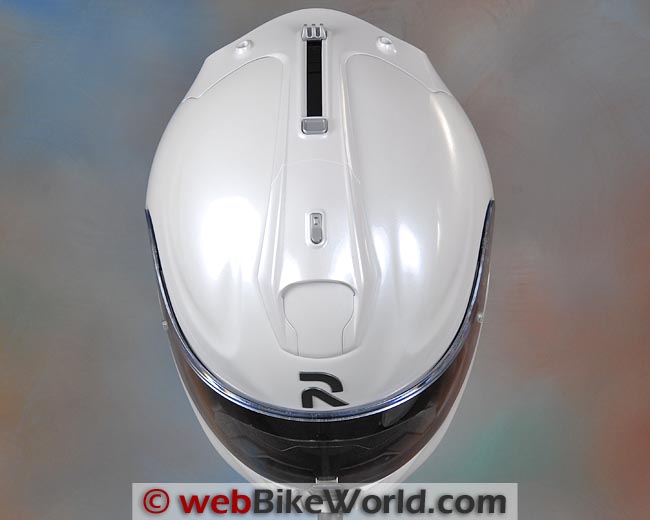
The HJC RPHA Max: Paint, Graphics and Overall Quality
It would be difficult for HJC — traditionally a “value” brand — to sell a helmet with a $459.99 list price if something wasn’t dramatically different from the rest of the company’s products.
While at first glance that difference isn’t dramatic, after spending some time with the RPHA Max and comparing it to the SyMax III, the differences are indeed noticeable.
For example, the cut lines on the RPHA Max are tighter and the switchgear definitely has a more precise feel.
The paint is an upgrade and the shell is a composite blend of four different materials: “a matrix of Carbon Fiber, Aramid, Fiberglass and Organic Non-Woven Fabric”, according to HJC.
Another difference that might not be noticed until the RPHA Max is placed directly next to a SyMax 3 is the overall shape and profile.
The RPHA Max is definitely slimmer and more compact, thanks to that difference in shell construction (the SyMax 3 has a fiberglass shell with polycarbonate rotating flip-up visor).
In fact, HJC said that one of the goals for the RPHA Max flip-up was to give it a shape similar to a full-face race helmet; e.g., the RPHA 10, previously known as the HJC RPS-10 (review).
While we didn’t notice the shape difference at first, as soon as we plopped the RPHA Max next to the SyMax 3, it was obvious.
The RPHA Max also uses a new and different locking mechanism for the rotating flip-up visor, with metal studs on the shell and a claw-like spring-loaded clamp in the chin bar.
The system has parts that appear to have been adopted from the SyMax 3 design, which was an improvement over the troublesome SyMax II design reported in our helmet latch failure in the Sy-Max II article.
The creamy-metallic Pearl White paint on our RPHA Max is outstanding, with a high-quality finish and clear coat. The standard White, Silver, Black and Matte Black are the only other named colors available at this time.
The switchgear is also different from that used on the SyMax 3 and it’s a definite upgrade. The top vent has an Arai-like rocker that works well and the large and well-shaped chin vent both works well and has a solid-feeling snap cover.
The liner doesn’t seem all that much different from the SyMax 3 and, in fact, doesn’t provide as much coverage but this allows better upper ventilation. The face shield, eye port gasket and lift tab have been redesigned and will be described in the following sections.
Score: The HJC RPHA Max rates an “Outstanding” rating for paint and overall build quality. See the Summary Table at the bottom of the page for a description of our rating system.
HJC RPHA Max Helmet Fit, Internal Shape and Liner
The trimmer external profile of the RPHA Max has resulted in a narrower internal shape that isn’t quite as “Neutral” as the SyMax 3.
The RPHA Max instead has a slightly narrow internal shape and it feels closer to the RPS-10 (now known as the RPHA 10) than the SyMax.
The sides are tighter and our size large RPHA Max feels like it runs about 1/2 size smaller than normal. It’s a bit tight for a size large helmet and especially for a flip-up, which typically has a bit more flex and give in its sizing than a full-face design.
The fit is probably a result of the three shell sizes made for the RPHA Max. The smallest shell fits the XS-S range; the medium-sized shell fits size M-L; while the largest shell fits the XL-XXL.
Since the size L is the largest size in the medium shell, the fit can be made closer, with less external bulk.
The RPHA Max feels tight on a round-shaped head and it also feels slightly shorter than normal in the front-to-back internal dimension.
In fact, two of the three evaluators mentioned that their chin touches the inside of the chin bar and the breath guard.
The HJC size chart indicates that the RPHA Max will fit a 59-60 cm head and that’s probably correct, although 60 cm is probably the maximum with no “wiggle room”.
So a 60.5 cm head, especially with a round shape, will probably find the helmet too tight and may have to go up a size to the XL.
The liner and padding are comfortable, but the ear pockets in the RPHA Max are shallow and this, combined with the slightly narrow internal profile, can make speaker installation a bit difficult.
The helmet does have a narrow gasket around the bottom, so the standard intercom mount that slips between the shell and the liner should work.
The Randolph Engineering Aviator sunglasses (review) fit with no problems in the RPHA Max.

More information on helmet fit can be found in the webBikeWorld Motorcycle Helmet FAQ page, along with the chart that lists the helmet weights of webBikeWorld reviewed helmets and also by shape on the webBikeWorld Motorcycle Helmet Shapes page.
Score: The HJC RPHA Max rates an “Outstanding” fit, comfort, liner, padding. The internal shape should fit motorcyclists with slightly narrow to neutral head shapes, but check the overall size to make sure it fits your head.
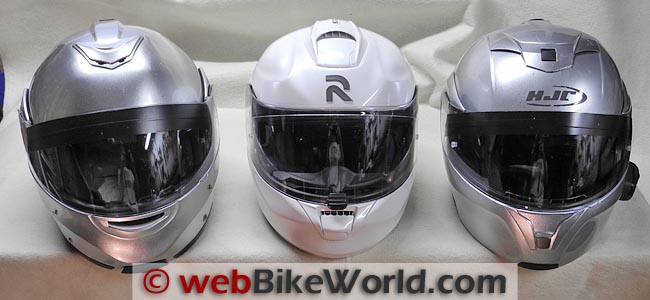
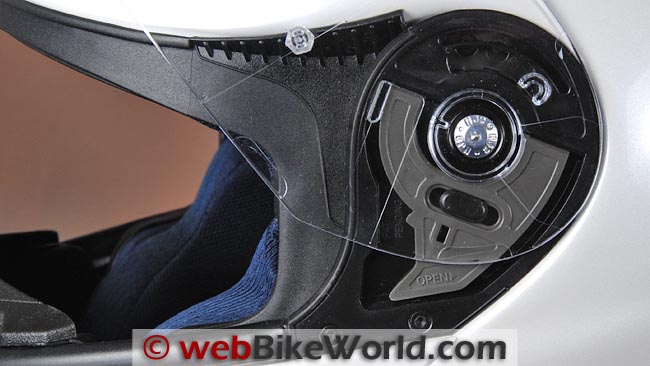
HJC RPHA Max Face Shield, Eye Port, Visibility and Internal Sun Visor
The closer fit of the RPHA Max in size large keeps the outer shell profile closer to the rider’s face, and this helps to provide better-than-average horizontal visibility.
The vertical visibility is about average, although the centrally located face shield lever and lock does not impede vision as it did in the RPS-10 we reviewed.
The face shield measures 2.15 mm thick and it is optically perfect and noticeably better than average. It is unmarked and does not have a VESC-8 stamping.
The face shield is Pinlock-ready and the helmet comes with a clear Pinlock anti-fog insert (review).
Although the face shield lifting mechanism does not have a small first detent, the face shield can be opened and placed so that it rests on the gasket and lift tab, which allows some ventilation during low-speed riding.
A total of three detents can be felt as the face shield is lifted through its travel.
Unlike the SyMax 3, the RPHA Max face shield remains closed with the rotating flip-up visor is raised. The face shield on the SyMax 3 can be lifted from the rotating flip-up visor even when it’s lifted to the raised position; this makes it easier to clean the shield.
The eye port gasket seals completely against the face shield and no water leaked through in our “leak down test”. The top vent and chin vent seem to have a good seal also, which should help prevent water intrusion.
The internal sun visor in the RPHA Max uses the same type of spring-loaded system found on the SyMax 3 and other HJC helmets.
It’s a full on-or-off system only, and it still has that extra “emergency” full stop position that will lower the sun visor one more step if the button is held and the lever is pushed simultaneously.
The sun visor provides excellent coverage, although we noticed some distortion when it’s lowered, which detracts from the overall effect.
The face shield removal system on the RPHA Max has been changed from previous HJC types, which is unfortunate.
The original HJC “RapidFire” removal system used on most HJC helmets was one of the best in the business and a model of efficiency.
Why helmet manufacturers feel the need to continuously change their face shield removal systems is an enduring mystery, but the “RapidFire II” system is a step backwards, in our opinion.
It’s a bit fussy and the spring-loaded lever is more difficult to push. The system is not as intuitive as the original and it took some studying of the owner’s manual to get the face shield to release properly.
There are three plastic molded pins on the inside of the face shield and care must be taken when the face shield is removed to ensure the pins don’t break.
The face shield doesn’t always seat correctly when it’s re-inserted and some pressing and fussing is in order to get it correctly located.

Score: The HJC RPHA Max gets an “Excellent” rating for visibility but a “Neutral” for the revised face shield release mechanism which is a step backwards from the typically excellent HJC “RapidFire” system.
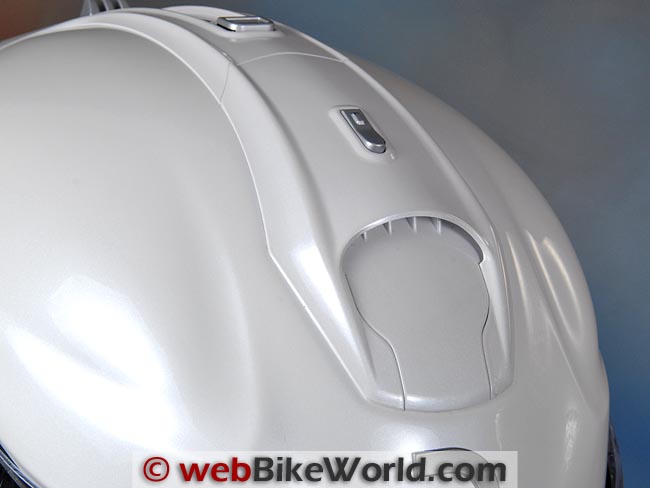
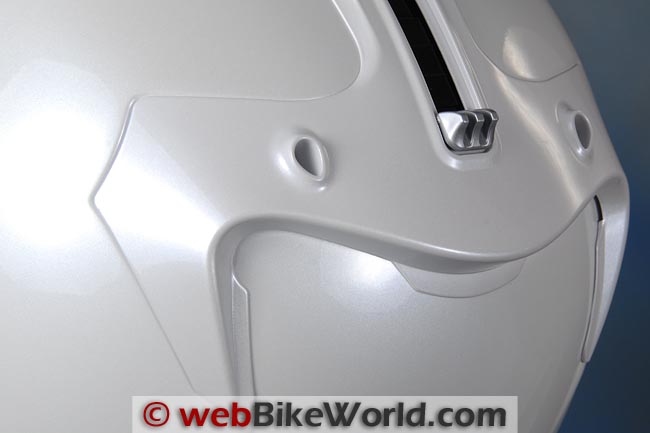
HJC RPHA Max Ventilation and Air Flow
One of the main differences between the RPHA Max and the SyMax series of helmets is in the improved ventilation provided by the Max
The SyMax 3 is a nice helmet overall and an upgrade from the SyMax II, but it is let down by poor ventilation. In fact, the SyMax 3 would probably be a top webBikeWorld flip-up helmet choice but for its poor ventilation.
The vent openings are small and are biased towards style rather than function.
Poorly designed vent openings are an all-too-common occurrence on motorcycle helmets but occasionally there’s one that gets it right.
Ironically, as we have pointed out in previous reviews, simpler is usually better when it comes to ventilation.
The top vent and chin vent on the RPHA Max are indeed simple; they are large scoops designed simply to capture and direct fresh air into the helmet, and they work well.
The top vent has a very Arai-like rocker switch and an assembly that simultaneously operates a pair of covers under the top vent air scoop. The air is directed down to the inside of the helmet through a pair of vent holes through the EPS.
The race helmet genes endowed to the RPHA Max come into play here.
There is no liner material on either side of the center liner strip covering the top of the head, so the air that comes in can travel along the channels molded into the EPS liner and then out the back through the exhaust vents.
The system works and only adds a minimal amount of noise when the top vent is open. It’s not the best top venting system we’ve reviewed but it’s better than average.
The chin vent is a nice, simple design of the large “sugar scoop” type. It points directly forward and doesn’t require the air to navigate around and through a network of barriers as found in most helmets.
While there are no direct vents inside the back of the chin bar, due to the rotating flip-up visor locking mechanism, when open the chin vent directs a large volume of air up on to the back of the face shield and on to the rider’s face.
The chin vent slider snaps open and closed with a solid feel. It’s large and easy to find when wearing gloves.
So overall, the HJC RPHA Max ventilation ranks among the best of any flip-up helmet we’ve reviewed and it equals the best full-face helmets. Flip-up helmets have notoriously poor ventilation, so this is indeed a revelation.

Score: The HJC RPHA Max ventilation system gets an “Outstanding” overall rating.
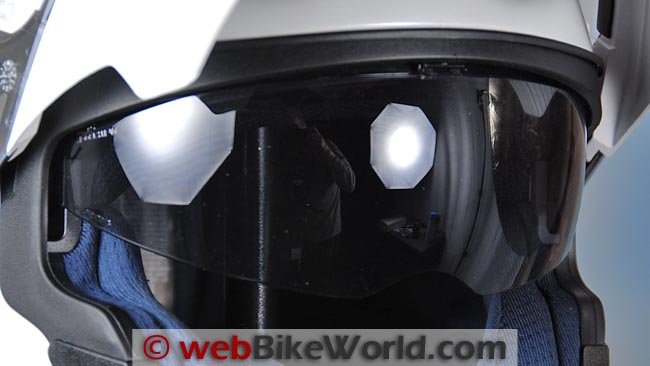
HJC RPHA Max Sound Levels
The combination of the sleeker external shell profile, the snug fit, the large chin curtain and the overall design have all helped the RPHA Max to keep noise levels low.
The helmet is one of the quieter flip-ups available and this was noted by all three evaluators.
Other than a slight increase in noise when the top vent is open (especially if a windscreen is directing air towards the top of the helmet), the RPHA Max is a relatively quiet helmet.
However, air directed at the top of the helmet from a windscreen can cause a fairly dramatic increase in noise levels from the top vent, so perceived noise levels will vary quite a bit, depending upon your situation.

Note that our helmet evaluations are a combined effort of several riders over time on different types of motorcycles with and without windscreens.
Evaluators wear correctly fitted, high quality ear plugs (even when evaluating motorcycle intercom systems).
Always protect your hearing when riding a motorcycle. See the wBW Earplug Reviews for more information on choosing and wearing earplugs.
Note also that perceived noise levels will vary, depending on the individual.
Noise can be caused by many factors, including helmet fit, the type of motorcycle and windscreen, wind speed and direction and even the rider’s clothing.
For more information on helmet noise, visit the wBW Motorcycle Helmet Noise page.
Score: I’ll give the HJC RPHA Max a “Very Good” rating for good noise control.
Helmet Weight
HJC promotes the light weight of the RPHA helmet series in the various advertising campaigns.
Our RPHA Max in size large weighs 1619 grams (3 lbs., 9-1/8 oz.), which is a good showing, making it among the top 10 lightest helmets we’ve reviewed.
he helmet is made in three shell sizes: XS-S, M-L and XL-XXL.
In comparison, the SCHUBERTH C3 DOT (review) in size large weighs a close 1603 grams; the Caberg Duke (review) in size large weighs 1633 grams and the Nolan N-104 (review) in size large weighs 1741 grams.
The HJC Sy-Max III (review) in size large weighed in at 1778 grams.
The lightest flip-up helmet ever reviewed on webBikeWorld and one of the lightest motorcycle helmets in the world is the Lazer Monaco (review) weighing in at 1406 grams in size large.
Note also that all of the helmets reviewed on webBikeWorld have been weighed and the weights are available on the wBW Motorcycle Helmet Weights page, along with a chart that lists the helmets by weight and shape on the wBW Motorcycle Helmet Shapes page.
Score: The HJC RPHA Max gets an “Outstanding” rating for low weight with good balance.
 Miscellaneous
Miscellaneous
The RPHA Max has a double D-ring chin strap with a plastic keeper snap. The helmet meets DOT safety standards in the U.S.A. and ECE 22.05 in Europe.
The chin strap padding is long enough and nicely padded. The helmet has a five-year warranty, which effectively covers the helmet for its usable life.
Fitting an Intercom to the HJC RPHA Max
The shallow ear pockets of the RPHA Max make intercom speaker fitment a bit of a problem, but it can be done. Otherwise, the helmet shell will fit the Interphone F5 (review) or the Sena SMH-5 (review).
 Conclusion
Conclusion
The HJC RPHA Max is an excellent new flip-up helmet, but it poses a paradox.
It’s a step-up from the SyMax III in a number of ways, but the jury is still out on whether it can compete with what is probably its closest competitors: the Nolan N-104 (review) in the U.S.A. or the Lazer Monaco (review) in Europe.
The Nolan N104 is has a list price $10.00 lower than the RPHA Max but the street price for the made-in-Italy flip-up is a very reasonable $339.99.
The RPHA Max has a list price of $459.99 and a current street price of around $414.00.
And let’s not forget what may very well be the closest competitor, HJC’s own SyMax III, which has a list price of $299.99 and a street price around $270.00, making it a relative bargain.
Is the RPHA Max worth $140.00 more than the SyMax III? That’s very difficult to say and a question that only you can answer. How much value do you put on lower weight, better proportions (due to the three shell sizes) and better ventilation?
Actually, that’s a valid question when comparing any motorcycle helmet.
But in this case, if the difference was closer to around $100.00 or slightly less between the RPHA Max and the SyMax III, there would be no question.
And the Nolan N104 may have the overall edge in build quality and features — and it has the optional Nolan N-Com Bluetooth intercom system, but the RPHA Max beats it in ventilation and lower weight.
The confused marketing that still persists for the RPHA brand doesn’t help much.
More than one motorcyclist who has seen the helmet did not recognize the logo as a stylized “R” and had never heard of the brand, and the HJC legacy may make selling a premium helmet difficult.
Part of the problem again is that the SyMax III is a pretty good helmet for the price.
However, SyMax III owners who try an RPHA Max may indeed be won over. HJC will have to crib sales from them and also from SCHUBERTH owners to make it work.
Here’s the bottom line on the RPHA Max: forget it’s made by HJC.
If you didn’t know who made this helmet, you’d probably think you were getting your money’s worth, with a quad-composite shell in three sizes, excellent ventilation and light weight.
If you’re in the market for a better-than-average flip-up helmet with premium features, definitely give this one a look.
From Chris B. (December 20, 2012): I was finally able to spend some more time with the RPHA helmet on my noggin and found a big problem when riding in cold temperatures.
On a morning�s ride I was completely unable to lock the face shield shut while wearing a pair of ordinary insulated riding gloves. No matter what I tried, I could not get the latch to catch.
This was a real distraction while riding.
On the way home later that day it had warmed well above freezing so I wore a lighter pair of gloves and still had a devil of a time securing the face shield.
I don�t know if it was because the sealing strips were stiff from the cold or not, but it was a real nuisance and made for a far noisier ride than necessary.
Also, I think it was mentioned in the review that some distortion was detected in the internal sun visor. I also found this to be true and could only stand having it down for a few minutes at a time before it became too annoying.
I have the exact same sun visor in my SyMax II and III and there is no distortion in either shade.
I think HJC needs to take a closer look at the RPHA because if they�re going to charge a premium price they need to ensure the quality�s there.
I�m not sure what the cause is for these problems, but it has certainly dampened my opinion of this helmet. For now I�ll stay with my SyMax III…
Owner Comments and Feedback
See details on submitting comments.
From “G.P.” (November 2012): “Thanks for another fine helmet review!
The UK’s SHARP test rating for the HJC RPHA Max helmet says “93% Percentage of impacts where the faceguard remained fully locked” (here).
The HJC Sy-Max III helmet SHARP rating is “40% Percentage of impacts where the faceguard remained fully locked” (here).
After the SyMax II helmet latch failure problems (mine was caused by a “light drop”), I�m really more careful about face protection.
Your review said “The RPHA Max also uses a new and different locking mechanism for the rotating flip-up visor, with metal studs on the shell and a claw-like spring-loaded clamp in the chin bar.”
However they did it, the HJC RPHA helmet latch has resulted in greatly improved protection, as crash tested in the UK.”
From “D.P.” (October 2012): “I have had a SCHUBERTH C3 (review) on my wish list for several years now but I could never get the spare change in my “cycle toys jar” to the $700 mark for the SCHUBERTH before some other thing “I had to have” for my bikes bled my change surplus back down.
So I was quite interested when Shoei and HJC stated they were coming out with high end flip-face helmets of their own, perhaps I could find one of them comparable but more affordable.
The webBikeWorld review of the Shoei Neotec (review) was favorable and I could save $100 by going that way instead of the C3, but I thought it best to wait on your review for the RPHA Max.
Then I found the RPHA Max on sale for $327 with points from other purchases that dropped my cost down to $298.
I checked the “cycle toys jar” and it was a done deal, had to go for the RPHA Max whether you had reviewed it yet or not.
I was surprised at a brand new model with such a low sale price, perhaps that is HJC trying to deal with their product identity crisis and generate sales traffic? I dunno�
It arrived within days; I ordered a medium in the Pearl White.
The fit and finish were top notch, and it included the Pinlock fog shield although I didn�t install it right away.
I can see where that will be required as the helmet is quite close fitting to the front of my face so that on an 85 degree day my breathing was able to fog the edge of the shield, popping the shield loose prevented the fogging.
I have yet to try it in cold weather.
I am happy that now that you have reviewed it that you won�t be giving me the big “L” salute with your thumb and finger to your forehead when you see my helmet with the big “R” on the front.”
From “B.C.” (October 2012): “Once again, the helmet manufacturers forgot about us “big head” guys…”
From “A.H.” (October 2012): “Again, thanks for another great review.
In light of what webBikeWorld has published regarding failure of the latching mechanism in HJC flip-up helmets (report), I thought the following statistics from SHARP (Safety Helmet Assessment and Rating Programme) would interest potential buyers.
The faceguard of the HJC RPHA Max remained fully locked in 93% of impacts during testing (test results). In contrast, the Sy-Max III scored 40% for the same test (test results).
From “T.G.” (October 2012): “I have worn HJC for years and am very interested in a lighter helmet from them as this year I will be retiring my most recent SyMax due to having it for 3 years now.
I am getting tired of the neck pain and headache from riding for 4 hours with the helmet on.
My biggest cop I can see with this new RPHA is the large ugly R on the front. Does it look like it can be peeled off so the helmet looks a lot better?
I love the fact that the HJC sticker comes off effortlessly on a new helmet, I am hoping that it’s the case with this one. Otherwise I’ll be looking at Nolan or another manufacturer for my next helmet.”
Editor’s Reply: The “R” looks like it is glued on, so it may be possible to remove it by careful warming with a heat gun, similar to the method used to remove glued-on trim pieces from a motorcycle or car.
From Chris B. (October 2012): (Editor’s Note: Chris is a regular webBikeWorld contributor). “Rick stopped by my house the other day to pick something up (or was it to drop an item off?) and brought along a modular helmet he had started to review.
He and Burn had already worn it on the road and since I�ve been wearing HJC modular helmets for over 10 years and have well over 200,000 miles wearing one form of SyMax or another, he was interested in my feedback on this new helmet.
First off, this is a brand I have never heard of: “RPHA”, with an insignia on the front that makes no sense to me, but then Rick points out that it�s actually made by HJC.
A peek inside the liner confirmed that it�s made by HJC and at the rear of the helmet above the DOT emblem is printed “RPHA MAX”. Puzzling to say the least.
Why would HJC produce a modular helmet then stick a different brand name on it? Beats me, but then I�m no marketing pro…
Rick and Burn have covered the fit, finish, details, etc. I�m going to point out my findings based on a comparison to the HJC SyMax helmets I currently own and wear.
Since I have the HJC SyMax II and III on the shelf in my garage the first thing we did was line them up for a side-by-side comparison. The differences are quite apparent, to say the least.
The RPHA (you can�t even make up a snappy acronym for it with the vowel at the end) helmet is much narrower than either SyMax and has far tighter seams where the chin bar meets the helmet on either side with none of the edges and overlapping panels present on both SyMax helmets.
The RPHA Max looks more like a full-face helmet than a modular. The only thing that gives it away is that small break in the chin bar on either side.
The face shield lift tab is in the center (which I�m happy to see) and it’s robust in size and includes a lock.
I haven�t had a locking face shield since my old Arai Quantum; I�ve heard of some complaints of face-shields blowing open, or shut, on the HJC SyMax, but that�s a problem I have never experienced.
I was a little bit disappointed to see that the face shield closes against the chin bar whenever the chin bar is opened fully. I have always liked the fact that the face shield will open farther than the chin bar on the SyMax.
It makes for very easy cleaning of the entire inside of the face shield and I can lower and lock the chin bar gently by sticking my hands through the eye port and squeezing the latches closed rather than having to slam it shut.
Since I�ve mentioned the chin bar, I found it to be far stiffer in its operation than either of my HJC SyMax helmets, especially when raising it all the way.
At the top of its stroke it�s so stiff the pressure needed to push it up causes the helmet tilt back on my head some. Hopefully this will loosen up with time.
As I said, this helmet seems to have been built with far tighter tolerances than either SyMax. I also noticed that the chin bar does not rise as far up as it does on either SyMax.
I noticed the eye port is smaller top-to-bottom on the RPHA, mostly because the breath guard rises up into the lower portion of the opening.
This helmet also has a chin curtain, which neither SyMax has, and probably contributes greatly to the difference in volume levels which I�ll get to in a bit.
Inside, whereas the SyMax helmets include padding over the entire top of the head, only a small strip of padding exists in the RPHA Max.
I didn�t notice this until after having worn the helmet on a couple of rides and happen to be looking inside.
It also has the same dampened internal sun visor as the SyMax III which rotates down more than far enough.
I have come to prefer a helmet with an internal sun visor because although I wear sunglasses, on those afternoons or mornings where the sun is literally in my eyes it�s a real blessing.
Once on my head, the helmet fits snugly and seems to “surround” my entire head with a better fit than either of my other flip-up helmets and I have plenty of room in front of my chin.
On the road, this has to be the quietest helmet I have worn in years! I always wear Hearos Extreme ear plugs and with the RPHA helmet on I can barely hear my BMW R1150GS running while riding.
Instead of the usual buffeting, I get more of what I would call “clean air” over the helmet.
No doubt the chin curtain is part of the cause, but I have to think the narrower profile and the overall lack of seams, gaps and panels has a lot to do with it too.
The downside to this might be far less ventilation on a hot day, but since the weather has turned cooler here in the Mid-Atlantic area I can only report on its performance in cool temperatures.
My first real outing, which was on the GS with the stock windscreen, was on a cool 52-degree (11 C) morning and the face shield was quick to fog up and stay that way unless I popped it open a tad. I guess the Pinlock insert would have fixed that.
I purposely didn�t wear a helmet liner of any kind and I could definitely feel air flowing over the top of my head when I opened the top vent.
There was an increase in noise with the vent open, but nothing objectionable. But, a few days later I took my 2000 BMW K1200LTC with the stock windscreen and a Laminar Lip out for a post-service road test and was shocked at the increase of noise with the top vent open.
This really stunned me, as I would have thought the results would have been the opposite between the bikes.
Overall I�m intrigued with this helmet and hope to be able to spend more time with it and report back.


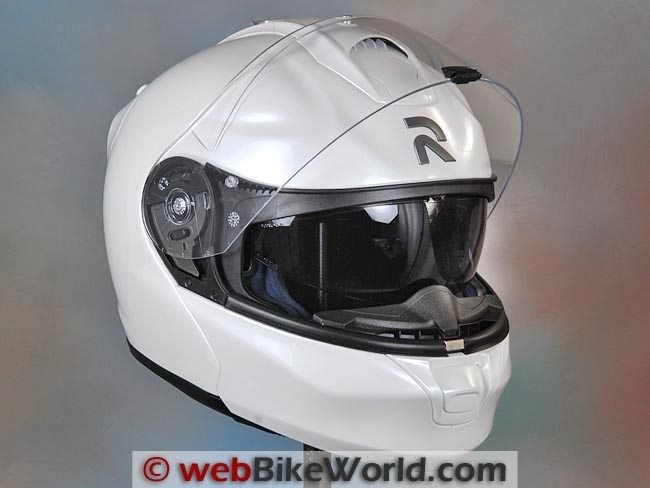
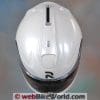
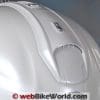
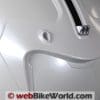
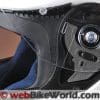
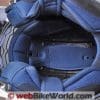
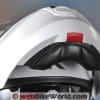
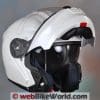
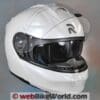
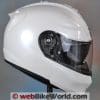
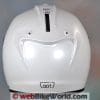
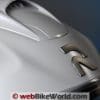
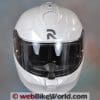
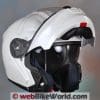
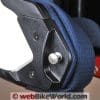
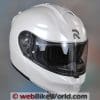
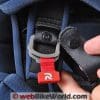
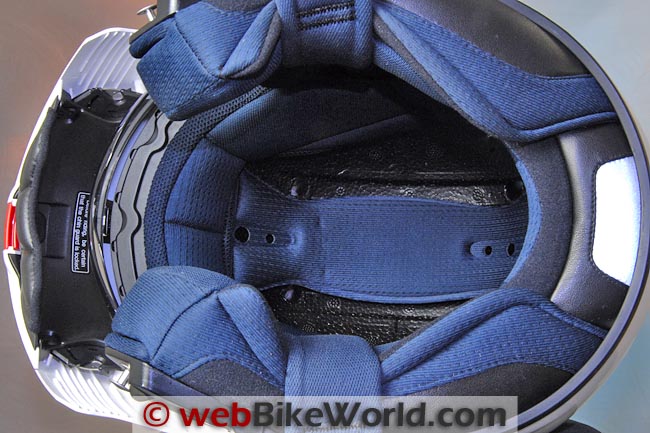
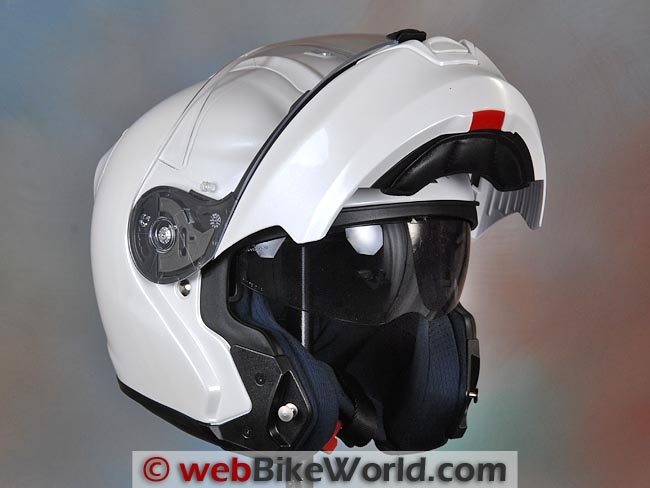 Miscellaneous
Miscellaneous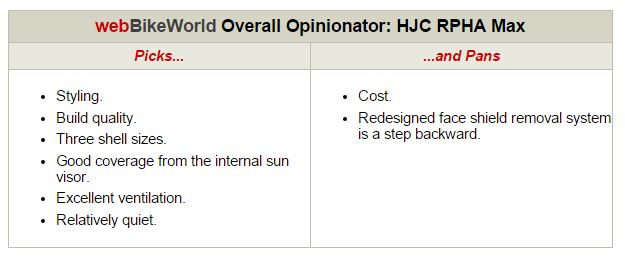 Conclusion
Conclusion